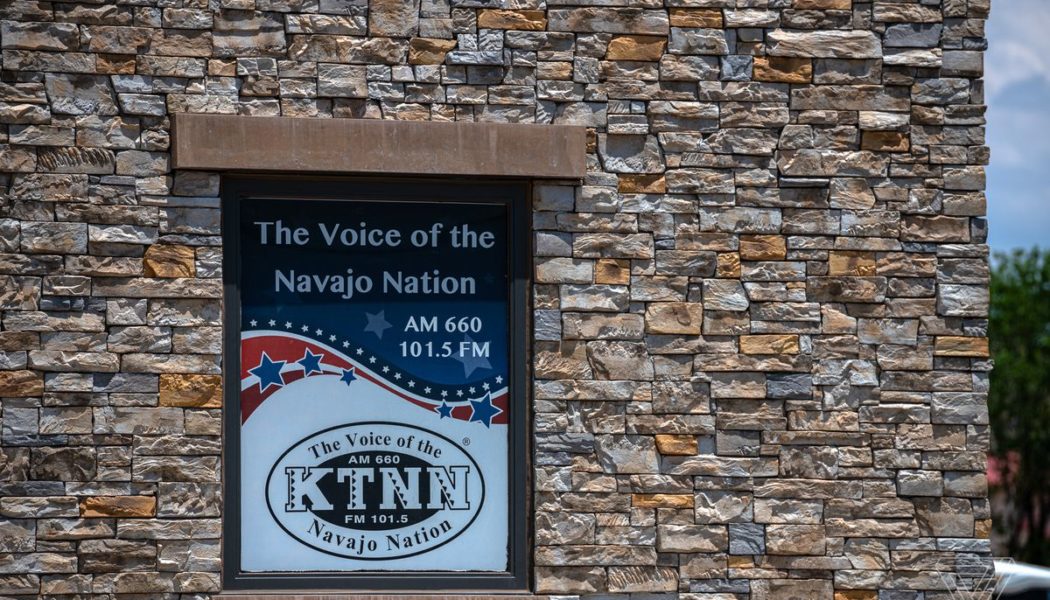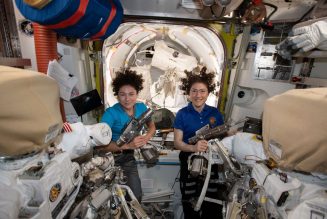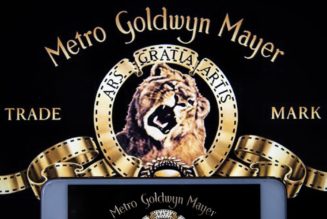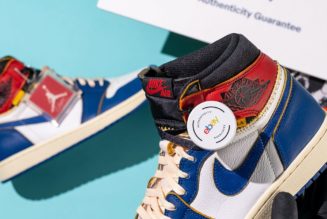KTNN radio station’s headquarters in St. Michaels, Arizona is less than ten minutes away from the Navajo Nation capital of Window Rock, but its reach encompasses all 27,000 square miles of the Nation across four different states. The station has been broadcasting bilingual content in both the Navajo language, Diné Bizaad, and English for over 35 years. But the station is quiet nowadays — many staff members are working from home if they can. That includes Dee Dixon who, after 15 years at KTNN, had to install internet access to her home an hour and a half away in Dilkon, Arizona so she could broadcast her 6AM show.
Her regular listeners are scattered. During the day, KTNN covers the majority of the Navajo Nation across New Mexico, Arizona, Colorado, and Utah. One can also tune into KTNN’s programming online via livestream from anywhere in the world. It is not the region’s only media. A few regional newspapers cover the reservation extensively, and Navajo Nation is also the only tribe in the country that owns, funds, and operates its own television station. But none of these mediums produce stories primarily in Diné Bizaad: radio is the only way to hear the language in local media.
:no_upscale()/cdn.vox-cdn.com/uploads/chorus_asset/file/22675137/aponders_210618_4531_0089.jpg)
When the COVID-19 pandemic bore down on Navajo Nation in early 2020, Dixon noticed a distinct divide between her regular listeners at home on the reservation and those outside of it. As Dixon worked on translating public health announcements and taking calls on the air, she noticed an uptick in listeners tuning in from Florida, Maine, Alaska, Louisiana, and Montana. Those callers away from home were hungry for local updates to know what was going on within the Nation — an ambiguous virus that no one understood thoroughly just yet was spreading. People wanted to know if their families were safe and just how transmission was occurring in a place where households are far flung across vast swaths of desert. But Dixon realized as her local listeners, specifically elders, called in that they wanted something different from her: they did not want to hear about the virus whatsoever, no matter how high the rates of infection in Navajo Nation were.
“According to Navajo tradition, you’re not supposed to give a name to anything that is not good for the reservation,” Dixon says. “The virus was like a monster. Traditionally, the more you talk about something like that, the more you’re inviting it into your home.”
Navajo Nation is the second-largest Indigenous tribe in the country with about 300,000 enrolled members, over half of whom live on the reservation. Much of the land is rugged and rural. Of those on the reservation, about 27 percent of households do not have electricity. Cellphone service can be spotty to nonexistent.
But transistor and car radios do not require electricity to function. Radio waves are not dependent on cell towers. In fact, KTNN was the last station in the country licensed for a clear-channel radio signal at 50,000 watts — a strength used in the early 1900s to provide rural America with radio that wouldn’t be vulnerable to interference.
A century later, radio across the Nation is just as vital because of the lack of consistent utility access. Stations that broadcast in Diné Bizaad are the bedrock of everyday Navajo life. And for the 7,600 people whose sole language is Diné Bizaad, there is no other option beyond radio to receive news, public health notices, and entertainment — that is the only link to the outside world. That population, whose sole language cannot be heard elsewhere, who are arguably the most vulnerable on the reservation to a lack of information access, were the ones who wanted to hear nothing about a virus that could kill them.
Gallup, New Mexico is often dubbed the Gateway to Native America due to the proximity to a variety of Indigenous lands — the border town’s neighbors include the southeastern quadrant of Navajo Nation, the Zuni Pueblo, and the Hopi Tribe. Downtown Gallup is home to KYAT-FM, another full-time Navajo-language radio station that also covers the entirety of the Nation.
:no_upscale()/cdn.vox-cdn.com/uploads/chorus_asset/file/22673581/aponders_210618_4531_0032.jpg)
Before the pandemic, KYAT focused on providing information to listeners in Diné Bizaad that included weather, rodeo commentary, and notices for the 110 chapters, or designated communities, within Navajo Nation. “We focused on anything that pertained to everyday life on the reservation,” says Sammy Chioda, general manager and president of Millennium Media, KYAT’s parent company.
Radio has carved a presence in Navajo life because of a logistical reality: folks spend a great deal of time commuting to go shopping in border towns or to work in them every day. The average Navajo must drive three hours round trip to shop for groceries alone. Long daily commutes are reserved for getting up to date on the news.
When the pandemic began, KYAT realized that listeners’ main concerns were unaddressed by major media outlets. Most early coverage of the pandemic veered toward showing what was happening in major cities, not rural America. KYAT’s program director Deni Gonzales remembers these early days viscerally. “We had callers ask if the virus was contagious to their animals — people have horses, cows, and sheep on their ranches,” Gonzales says. “They asked, ‘Can my cattle get this? Can they give it to me?’ There were so many questions we didn’t have the answers to yet.”
In May 2020, Navajo Nation’s infection rates surpassed New York’s, which had been, until then, the highest in the country. Nearly a year later, just over 30,000 individuals have been diagnosed with COVID-19 — roughly 17 percent of Navajo Nation — and 1,258 of those infections have resulted in deaths.
“We always get the bad brunt of that attention,” Chioda says. “One of the things I can’t stand is that sometimes people labeled this as a Navajo problem.” Gonzales reiterates that the publicity of infection rates on the tribe left the community feeling particularly maligned. “The virus is everywhere — when national reporters come, they can give us a big black eye.”
:no_upscale()/cdn.vox-cdn.com/uploads/chorus_asset/file/22675131/aponders_210618_4531_9919.jpg)
As the pandemic wore on, survivors called into Dixon’s show wanting to share tips on what common Navajo herbs they believed cured them of the virus. Various DJs at KTNN felt conflicted about allowing audiences to share what, at best, could be cultural remedies or placebos and, at worst, could be dangerous misinformation. Folk home remedies, like putting steak on a bruise, degrade quickly depending on the severity of illnesses. For Dixon, a memory surfaces of a loved one explaining that when they sprained an ankle, they visited a witch doctor who rubbed oil and herbs on their ankle and, thinking they were curing the pain, twisted the ankle further.
But more harmful suggestions were coming from outside the reservation, much of it motivated by financial gain. In 2020, there was widespread misinformation about ingesting substances like colloidal silver to cure coronavirus. That visibly took hold in Gallup — the local co-op displayed the blue liquid prominently at checkout during the height of infections. As early as March 2020, then-President Donald Trump was also touting the benefits of hydroxychloroquine, a drug commonly used for malaria, as a cure to COVID-19 even after the drug was debunked for antiviral usage.
With misinformation, Dixon chose to take a step back to see a bigger picture. Common herbal remedies in Navajo culture have been used for hundreds of years and are often made of local plants. The recommendations her listeners wanted to share were not necessarily created or promoted to profit off of plight — they were things that residents have been using all of their lives domestically.
“I allow survivors to share their recommendations, but I don’t tell people that they need to take these herbs to get better.” For Dixon, letting survivors share their stories was a way for people to stand on a leg of tradition. Local remedies were familiar in the face of something foreign and lethal. It was a way for her community to reach out into the void and care for one another — to fight not just the pandemic, but the isolation.
:no_upscale()/cdn.vox-cdn.com/uploads/chorus_asset/file/22673591/aponders_210618_4531_0042.jpg)
If one goes on a drive in any direction outside of Gallup, they’ll see the names of the dead. Fluorescent neon poster boards are taped to signs on rural highways with an arrow drawn in the direction of a nearby car. Next to the car, family members are stationed at a folding table, ready to welcome loved ones and receive donations to produce funerals for the recently deceased. Even now as the Nation has taken a massive turnaround with vaccination and cases are dwindling, any drive — to the pharmacy, grocery store, home — is punctuated with loss.
Radio stations like KTNN and KYAT are responsible for the drive-through donation sites. They have broadcast funeral announcements throughout the pandemic, directing far-flung family and friends across the Nation to drop off contributions to honor the dead. Both Chioda and Dixon are used to these everyday announcements and the implications from them — it is a part of their job. “Every time there was a wave, we were hitting 30 to 40 funeral announcements a day,” Dixon says. “As soon as some went out, more would come in.”
When Chioda reflects on the whirlwind effect of the COVID-19 pandemic on local radio, he responds swiftly. “Imagine the pandemic here without radio. People take radio for granted and never realize it until it’s gone. But this is the local medium.”
:no_upscale()/cdn.vox-cdn.com/uploads/chorus_asset/file/22673557/aponders_210617_4531_0011.jpg)
Gonzales remembers one particular caller from last year — a woman on Navajo Nation was in a deep depression after her husband passed. She did not want to leave the house, but she tuned into KYAT every day to listen to one specific DJ — his jokes, quips, and music choices. One day, she worked up the nerve to call the station. “That woman told me that he got her through dark times — hearing him every day, it was like he was a friend. That changed her life, and if we did that with one person, how many other people have we done that with that we don’t know about?”
For Dixon, the pandemic was personal. She lost her younger sister to the virus. “My sister was a healthy person and she got sick and she didn’t even last… It took her.” Through tears, Dixon reflects on how losing her sister changed her life — she has started exercising, taking vitamins, and sharing her self-care efforts on the air. The opportunity to broadcast in Diné Bizaad throughout the pandemic, even with the criticism from elders and the ethical dilemma of promoting remedies, came down to reconnecting with her own culture. “A lot of the time, us Navajos forget our roots,” she says. “This made us take a step back to remember where our sacred bundles are, our prayers, our songs, our spiritual beliefs. It brought all of that back to us.”
About an hour north of Gallup lies a swath of the Continental Divide on Navajo Nation. It is the midpoint of North America, the spot where rainwater splits to the east or west and flows into bodies of rivers. On the drive, stark-white chapter houses and sprawling ranches lie on either side of the country roads. Veering into the Continental Divide, what locals call The Canyon, the elevation is presented on a sign: 7,530 feet. To the east, red-rock bluffs are so dense with cedar and piñon trees that the rock isn’t visible beneath. To the west, rust-colored sandstone is shaped by the wind into squat hoodoos and natural arches. There is no home in sight. But if you turn the dial to 94.5, KYAT is clear even within the canyon walls: slow-dance country songs play and, in between ballads, a DJ gives updates in Diné Bizaad, for those who need to hear it.










